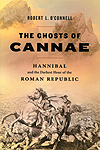
Ghosts of Cannae: Hannibal and the Darkest Hour of the Roman Republic, by Robert L. O’Connell, Random House, 2010, $27
Outnumbered and hundreds of miles from his base in Spain, Hannibal accepted battle against a Roman force that must have appeared invincible. And against any other general, the Romans would have rolled over the Punic army assembled on the fields near Cannae. But Hannibal was a military genius who, on this August day in 216 BC, was at the top of his form. He drew the attacking Roman legions deep into the center of his position, then launched his flanks forward in a crushing double envelopment. By the end of the day, nearly 50,000 Romans lay dead or dying. Despite his decisive victory, Hannibal believed the walls of Rome impenetrable and declined to march directly on the city, whereupon his cavalry commander, Maharbal, said disgustedly, “You know how to conquer in battle, but not how to make use of your victory.” So it was that the apparent master of Italy threw away his greatest triumph.
Spared from siege, Rome recovered, raised new legions and dedicated itself to the ultimate defeat of both Hannibal and Carthage. In Ghosts of Cannae the author presents a fast-paced narrative of the entire Second Punic War, the two-decade struggle to determine which would be master of the Mediterranean—Rome or Carthage. Writers have exhaustively covered this story, and the ancient warfare specialist is unlikely to find anything new here, yet the book remains a worthy read, if only for the Cannae battle reconstruction. Given the typically limited firsthand sources, historians find ancient battles notoriously hard to reconstruct, but O’Connell takes the evidentiary challenge head on and provides a reconstruction sure to arouse lively debate among historians.
For the general reader, Ghosts of Cannae is a delight. O’Connell stays true to the sources, synthesizes the best of what other historians have written and gives readers a gripping story. It is refreshing that O’Connell avoids falling into the “cult of Hannibal” trap. He allows that, despite his great victory at Cannae, Hannibal almost single-handedly led Carthage into a greater strategic defeat, leaving it powerless to resist brutal Roman vengeance two generations later. O’Connell maintains his focus on the eventual victors by anchoring his story on the Roman survivors of Cannae and the man who restored their honor, Scipio Africanus.
The Roman Senate banished the approximately 10,000 Roman survivors of Cannae to Sicily, where they languished for most of the Second Punic War—until Scipio arrived in their midst. Understanding the dishonored legions’ deep need to regain their reputation and Rome’s respect, Scipio made them the core of the army he led into North Africa and onto the field of Zama. There they destroyed Hannibal’s veterans, made Rome master of the Eastern Mediterranean and replaced the stain of defeat and dishonor with victory and glory.
In the final tally the Battle of Cannae was an empty victory. After a brief period of panic Rome rebuilt its legions and redoubled its efforts. Thus Hannibal’s win at Cannae proved but a single glorious moment in a war Carthage should never have undertaken.
Many a general is fond of the idea that someday he, too, will one day lead victorious troops in a second Cannae. For the historian looking for an absorbing history of the battle that has enthralled these generals and military historians for centuries, look no further than Ghosts of Cannae.
—James Lacey




